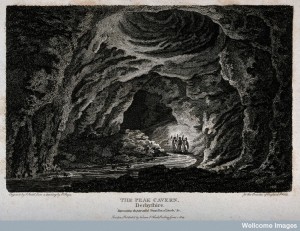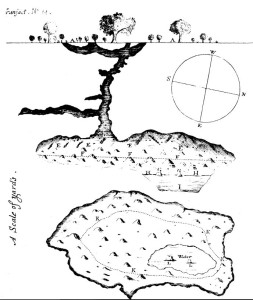by Lisa Smith (Regular Contributor)
This is a tale that ‘amused the Country’ and been sent to the King of England and the Royal Society.
In 1669, some lead miners discovered a large hole at Pen Park, three miles from Bristol and three miles above the Severn. It was—in the words of a nineteenth-century historian—‘what women would call an ugly, deep, dangerous hole’.

Geology: two visitors being shown the attractions of Peak Cave, 1803. Credit: Wellcome Library, London.
Captain Sturmy, an ‘inquisitive’ sea man who had published a book on navigation, decided to navigate the mysterious hole. Using ropes, he descended thirty-one full fathoms down, ‘into a large Place, which resembled to us the form of a Horse-shoo’. The cavern had a strange beauty: the floor was of white stone and enamelled lead ore, while the hanging stones were covered in saltpetre that ‘time had putrified’.
A large river in the cavern measured twenty fathoms broad and eight fathoms deep. In order to determine whether the water ebbed and flowed, they remained beside it for five hours, but there was no change. The water was fresh and sweet, clearly not sea water. They continued along the river for thirty fathoms, where they found ‘a great hollowness in a Rock’ thirty feet above them. The miner climbed up to explore the chamber, going in about seventy paces. Sturmy lost sight of him, but could easily hear when the miner ‘chearfully call’d’ that he had found ‘a Rich Mine’. Just then, the miner’s
joy was presently changed into amazement, and he returned affrighted by the sight of an Evil Spirit, which we cannot perswade him but he saw, and for that reason will go thither no more.
Miners and mine spirits—whether goblins or knockers—have a long history. Agricola, for example, referred to the popular Saxon beliefs about mine goblins in his De Re Metallica (1556); their presence was thought to indicate poor quality ore. Such beliefs were also common in Britain, with them being called knockers in Cornwall and goblins in Wales. British mine spirits were not necessarily evil or unlucky, unlike the German ones… or the one haunting Pen Park Hole.
The men remained several more hours, despite the scare, and climbed back up without difficulty. Four days later, Sturmy found himself ‘troubled with an unusual and violent Head-ach’, which he attributed to his time in the ‘vault’. He died soon after. The cavern seemed cursed, between Sturmy’s death and the ominous spirit; for years, nobody had anything to do with it.
This is where Sir Robert Southwell picked up the story in 1683. When Captain Collins, commissioned to undertake a coastal survey, sailed into port, Southwell knew he had found the man who might have the ‘courage’ to find the bottom of the hole. Collins had voyaged around the world, after all!
In September 1682, Collins and several of his men went exploring over two days. In total, though, they only spent a total of 3.5 hours in the cavern—a much shorter time than Sturmy and the miner. They were equipped with ropes and tackle, measuring lines, candles, torches… and a speaking trumpet. Collins and his team measured the cave much more precisely, finding, for example, that the entrance was only 39 yards (just under 20 fathoms). Collins was, indeed, able to measure the depth of the hole: 59 yards. The measurements for the body of water, which they found to be a pool surrounded by mud rather than a river, were much smaller: 27 yards long, 12 yards broad and 5 ½ yards deep. There was a suggestion, though, that the pool was sometimes much larger.
And as to the chamber above? It was not nearly so high nor deep. They found there only ‘Some appearances of Sparr, but nothing else in it except for some Bats.’
Despite their relatively short time below ground, the Collins party had ‘observed all things’, Southwell assured the readers of the Philosophical Transactions. The cavern was not even so deep that the speaking trumpet was needed to communicate with those above. And there was certainly no ghost in the upper chamber.
In effect, the Collins expedition had measured away all the mysteries of the deep that Captain Sturmy had found. The spirit of Pen Park Hole was truly dead.
Sir Robert Southwell’s account, which I’ve used, was published in the Philosophical Transactions of the Royal Society in 1683. For more details on Pen Park Hole today, see the website.

